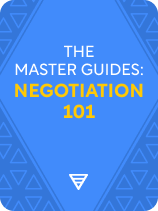

This article is an excerpt from the Shortform book guide to "The Master Guides: Negotiation" by Shortform. Shortform has the world's best summaries and analyses of books you should be reading.
Like this article? Sign up for a free trial here.
What are the best negotiation tools and techniques? What dodge-and-counterpunch negotiation moves should you use?
When negotiating with a partner who’s throwing everything at you, you need to be prepared for their moves. Additionally, you should consider what type of boundaries and conditions you want to set for the negotiation.
Discover more about these necessary negotiation tools and techniques below.
Know Your Moves (and Your Counterpart’s)
Never Split the Difference cautions that to prepare for a negotiation, you need to plan some specific dodge-and-counterpunch moves to use—especially when you’re going up against a seasoned negotiator who has good negotiation tools and techniques.
Dodging Tactics
These are what you do to deflect your counterpart’s “punches”—aggressive threats, demands, and deadlines they may throw at you to pressure you into making a deal on their terms. You can use open-ended questions to say “no” without actually using the word, or pivot to non-monetary terms. Say things like, “Let’s put price aside for now. What else can you offer that would make this a good deal for me?”
Strategic Umbrage
You need to be prepared to hit back without getting angry. Voss champions a technique psychologists call “strategic umbrage.” This means being genuinely angry (not faking it), but in control of your emotions. The key to strategic umbrage is getting angry at the offer being made—not the person making it. Saying, “I’m afraid there are no circumstances that would make that proposal work for me” in a displeased—but measured—tone is a good way to leverage a little bit of anger to your advantage.
Nonstrategic umbrage would mean letting your angry emotions completely dictate your negotiating posture in a way that’s counterproductive. In practice, this would involve losing your cool and making personal attacks against your counterpart by saying things like, “If you think I’d even consider that pathetic excuse of an offer, either you’re an idiot or you think I am.”
Determine Your Boundaries for the Negotiation
Negotiation experts write that there are a few tools you can use to determine your boundaries for the negotiation—specifically, when you’d walk away from a negotiation, your minimum conditions for a deal, and the range of outcomes that would be acceptable to both you and your counterpart.
Find Your BATNA and Learn When to Walk Away
In Getting to Yes, Roger Fisher and William Ury write that one tool to prepare for a negotiation is to determine your best alternative to a negotiated agreement (BATNA). Knowing your BATNA helps you decide when and whether it’s better to accept the deal or to walk away.
Their logic for using BATNA is this:
- The purpose of negotiating is to get better results than you’d get without negotiating.
- Therefore, when negotiating, you need to know your best alternative to negotiation in order to know whether to accept an agreement.
- Once you know this, measure any proposed agreement against your best alternative or BATNA. It will protect you from accepting a bad agreement, as well as from rejecting a good agreement.
RV and ZOPA: Finding You and Your Counterpart’s Conditions for a Deal
In Negotiation Genius, Deepak Malhotra and Max Bazerman supplement Fisher and Ury’s BATNA concept with two additional negotiation benchmarks to determine ahead of time: the RV and the ZOPA.
Your reservation value (RV) is the worst deal you’re willing to accept in your current negotiation. For example, this might be the highest price you’re willing to pay or the lowest price at which you’re willing to sell. They recommend figuring out what your counterpart’s RV is as well.
Your zone of possible agreement (ZOPA) is the space between your RV and your counterpart’s. For example, if your lowest selling price is $10,000 and the highest your counterpart’s willing to pay is $15,000, then the ZOPA is between $10,000 and $15,000. This range gives you a more tangible measurement of how much value you can either claim or surrender during a negotiation. To claim the most value, you want to make a deal as close to your counterpart’s RV (their worst potential deal) as possible.

———End of Preview———
Like what you just read? Read the rest of the world's best book summary and analysis of Shortform's "The Master Guides: Negotiation" at Shortform.
Here's what you'll find in our full The Master Guides: Negotiation summary:
- How we're always negotiating, even if we don't realize it
- A synthesis of ideas and recommendations from leading negotiation experts
- A look into two different approaches to negotiation: emotional and rational






